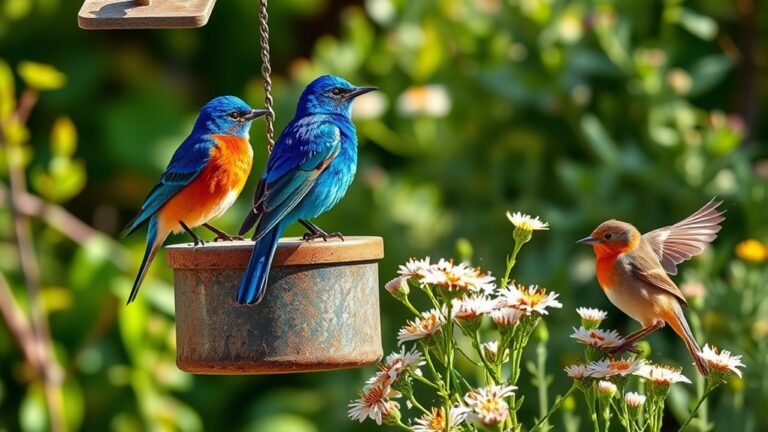Wintertime Backyard Birds
In winter, your backyard becomes lively with birds. These birds adapt to survive the cold weather. You may see the bright yellow of an American goldfinch or the muted gray of a dark-eyed junco. These birds are important for your local ecosystem and can show you how nature functions.
How do these birds manage the cold? They have specific behaviors that help them thrive. For example, they may shift their diets or find sheltered spots to stay warm. Observing these strategies can deepen your understanding of your own environment and the wildlife around you. Enjoy watching and learning from the birds in your backyard this winter.
Key Takeaways
- Attract winter birds like American goldfinches and dark-eyed juncos by providing diverse feeders and food options in your backyard.
- Utilize tube feeders for small birds and platform feeders for larger species, ensuring a variety of foods is available.
- Create a bird-friendly habitat with native plants, dense shrubs, and birdhouses tailored for specific species to offer shelter and resources.
- Observe and document bird behaviors and sightings in a journal to track patterns and enhance your birdwatching experience during winter.
- Engage with local birdwatching communities to share observations, knowledge, and participate in organized bird counts or events.
The Importance of Backyard Birds in Winter

Winter may seem quiet, but backyard birds bring life to the cold months. Watching these birds offers many benefits. Their bright colors and lively movements stand out against the white snow, giving you joy and visual interest.
Birds help nature stay balanced by spreading seeds and controlling insects. By feeding them during winter, you support not only the birds but also the entire ecosystem they're part of.
Observing their interactions helps you connect with nature, which can enhance your sense of belonging and appreciation for the world around you.
Common Winter Birds to Spot
Winter changes your backyard into a place filled with different bird species. During this time, you may see birds like the American goldfinch and the dark-eyed junco. Notice their colors and sounds to help you identify them.
Watching these birds can help you understand their migration patterns as they adjust to cold weather. Observe how they search for food on the ground or move between branches. Create a mental list of what you see, including their size, shape, and markings.
This practice connects you with your local ecosystem and other birdwatchers. Enjoy the beauty of nature while you learn.
Attracting Birds With Feeders

Setting up feeders in your backyard is an effective way to attract winter birds. Here are some simple options to consider:
- Tube Feeders: These feeders work well for small birds like finches. They keep seeds dry and are easy for birds to access.
- Platform Feeders: These open feeders can hold larger birds like jays and doves. They provide space for different types of food.
- Suet Feeders: These feeders attract woodpeckers and other birds that eat insects. Suet offers essential fats during cold months.
Place your feeders in quiet and sheltered areas. This helps attract more birds and creates a welcoming environment.
Enjoy watching the lively activity in your backyard!
Top Birdseed Choices for Winter
Choosing the right birdseed for winter helps attract birds and supports their survival during the cold months. Black-oil sunflower seeds are a popular option due to their high fat content, providing energy for birds.
Nyjer seeds are great for attracting winter finches like goldfinches and siskins. Their small size and unique taste appeal to these colorful visitors, enhancing your yard's beauty.
Millet is another nutritious choice, favored by ground-feeding birds.
Seed blends are also available, but select those with a high proportion of preferred seeds to maximize variety.
Creating a Bird-Friendly Habitat

Creating a bird-friendly habitat requires more than just providing birdseed.
You should create a welcoming space that supports birds' needs during winter. Here are some simple steps to help you attract birds and offer them shelter:
- Use Native Plants: Select local shrubs and trees that produce berries. These plants provide food and cover for small birds.
- Install Birdhouses: Put up birdhouses that suit specific species. Make sure they're protected from strong winds and are the right size for the birds you want to attract.
- Set Up Feeding Stations: Place several bird feeders in your yard. Use different types to cater to various birds' eating habits. Keep them stocked with nutritious seeds.
By following these steps, you can create a safe and inviting habitat for birds all winter long.
Enjoy watching them thrive in your garden!
Water Sources for Winter Birds
To create a bird-friendly habitat in winter, include reliable water sources. Natural water sources, like streams and ponds, may freeze, limiting access for birds.
Adding heated birdbaths to your yard can help. These birdbaths provide essential water for drinking and bathing when temperatures drop. Watching various bird species visit your heated birdbath is enjoyable. You can see them splash and drink, displaying their bright colors against the winter scenery.
If you have natural water sources, check that they aren't completely frozen. By providing water, you create a welcoming space for winter birds, enhancing your birdwatching experience right at home.
Shelter Options in Your Backyard
Winter can be tough for birds. You can help them survive by providing shelter in your backyard. Here are some simple ways to create safe spaces for them:
- Birdhouses: Build birdhouses using untreated wood. This allows birds to use natural materials like twigs and leaves for nesting.
- Native shrubs: Plant dense, evergreen shrubs. These bushes give birds food and protection from cold weather.
- Brush piles: Create a pile of branches and debris in a quiet corner of your yard. This serves as a safe spot for smaller birds.
The Behavior of Winter Birds
As winter arrives, you'll notice changes in the behavior of birds in your backyard. Many birds form flocks to stay warm and safe. You might see finches, sparrows, and chickadees gathering together to share food resources. This behavior helps them survive the cold months.
Some birds migrate south for the winter, while others stay and visit your feeders. This shows their ability to find food despite the challenging weather.
Your backyard may become lively with these winter birds. They communicate with chirps and calls, creating an enjoyable atmosphere that celebrates the season. Observing these birds can strengthen your connection to nature.
Unique Adaptations to Cold Weather
When temperatures drop, many birds show special traits that help them survive in cold weather.
Here are three ways they do this:
- Feather Insulation: Birds fluff up their feathers to trap air. This helps keep them warm by creating a barrier against the cold.
- Metabolic Adjustments: Birds raise their metabolic rates during winter. This process generates extra body heat, helping them stay warm at night.
- Color Changes: Some birds grow thicker and darker feathers in winter. This change allows them to absorb more heat from the sun.
These adaptations help birds thrive even in harsh winter conditions and make them fascinating to observe.
Birds' Foraging Techniques in Winter
Birds face challenges finding food in winter, but their foraging techniques adapt effectively.
Woodpeckers search tree bark for hidden insects, using strong probing skills.
Chickadees often move in flocks to improve their chances of finding seeds or berries.
Jays cache food by hiding acorns in different spots to ensure they've enough to eat.
Sparrows and finches look for scraps beneath feeders, taking advantage of any leftovers.
Each of these methods shows how birds use their energy wisely and adapt to survive winter.
Watching these behaviors helps us appreciate our feathered friends more.
Engaging Activities for Birdwatchers
Winter birdwatching is thrilling and offers challenges for bird lovers.
Participating in activities during this season can improve your knowledge and enjoyment of winter birding. Here are three fun activities to try:
- Birdwatching games: Compete with friends or family. See who can spot the most bird species in one outing or keep a tally of sightings over the entire season.
- Themed observation days: Choose specific days to watch particular bird types, such as finches or woodpeckers. Focus on their winter behavior to gain a deeper insight.
- Feeder matching: Try different feeders and seeds to attract a variety of birds. This hands-on activity helps you learn about their preferences while enhancing your outdoor experience.
These activities will enrich your winter birdwatching and help you connect with fellow bird enthusiasts. Enjoy the season!
Keeping a Birding Journal During Winter
Keeping a birding journal in winter is a great way to note your observations of birds and their behaviors. As you use different birdwatching methods, focus on the species that come to your backyard.
Record the time, weather, and what they like to eat in your journal. You may see trends, like certain birds arriving with stormy weather or visiting feeders during snow.
Describe the colors and behaviors of the birds to add depth to your notes. Sharing your discoveries with other bird watchers can create a sense of community.
Your journal becomes not just a record of what you see, but also a way to connect with nature and others who enjoy birding.
Frequently Asked Questions
What Are the Best Times to Observe Winter Birds?
To observe winter birds effectively, go out early in the morning and late in the afternoon. During these times, birds are feeding and more visible. This is your chance to enjoy the beauty of nature and connect with it deeply. Watching birds can bring joy and a sense of peace, making these moments special.
How Do Winter Birds Find Food in the Snow?
Winter birds find food through several strategies. They hide seeds under the snow and use their beaks to probe for food. Their sharp eyesight and strong memory help them remember where they have hidden food. By using these skills, they survive and thrive in harsh winter conditions.
Do Winter Birds Migrate or Stay in One Place?
Some winter birds migrate to warmer places, while others stay in their local areas. Birds that migrate often seek out climates where food is more abundant. Those that remain adapt to cold conditions and find ways to survive. Watching their behaviors helps us understand how they cope with seasonal changes and environmental challenges.
Are There Any Harmful Birds to Watch for in Winter?
In winter, watch for sparrows and crows. These birds can compete for food, which may harm smaller bird species. Sparrows may hunt others for food, while crows can dominate feeding areas. Observing these interactions helps you understand local wildlife better.
What Should I Do if I Find an Injured Winter Bird?
If you find an injured bird, first observe it closely. Check its condition and look for any visible wounds. You can apply basic first aid if needed. After that, contact local bird rehabilitation services for help. These professionals can provide the care the bird requires.

Hello, I’m Amelia White, the founder of birdsfanatic.com. As a lifelong bird enthusiast and spiritual seeker, I’ve always been fascinated by the mystical connections between birds and the human experience. On this site, I share my knowledge and insights into the symbolic meanings and spiritual significance of various bird species, exploring their roles in mythology, folklore, and cultural traditions. Join me on this journey into the world of birds, where we’ll discover the hidden wisdom and guidance that these magnificent creatures have to offer.







